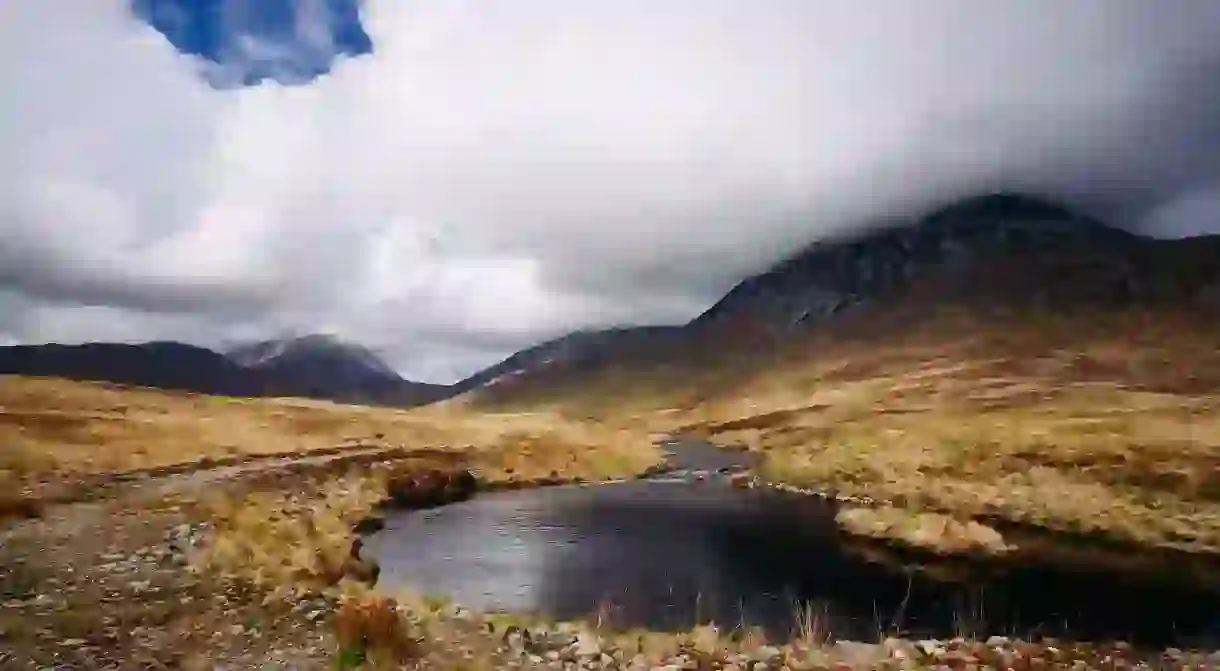The Remote Scottish Island Where George Orwell Penned 1984

A great mass of rugged land inundated with clans of noble red deer that roam freely as they please, replacing people as the primary landlords, the Isle of Jura is one of Scotland’s last wildernesses. With over 5,000 red deer and around 200 people living harmoniously on the island, Jura is held in high regard by those seeking true solo serenity. It was this same spirit of solitude that lured George Orwell to the island to finish his dystopian masterpiece, Nineteen Eighty-Four.

Found anchored in the Inner Hebrides off Scotland’s west coast just a stone’s throw from Islay, Jura bears a history, like most Scottish isles, that’s swaddled in folklore and jam-packed with Viking invasions, clan disputes and ancient settlers. Today, such histories live on through the Iron-Age forts, age-old burial grounds and Rubik’s cube of standing stones. Described by Orwell as an ‘extremely un-get-at-able place’, Jura proves that less is best with its one main village settlement, Craighill, which boasts one lone road, the Jura hotel, one pub, a church and the renowned Isle of Jura Distillery.

Orwell first set foot on Jura in 1946 following the unexpected death of his wife and recent adoption of their son Richard. In a desperate bid for personal space and solitude, due to his grief and star writer status generated from Animal Farm, Orwell rented a farmhouse on Jura called Barnhill. He arrived with nothing but a camp bed, table, chairs and a typewriter.
Standing alone free from any manner of bells and whistles, Barnhill boasted soul-grasping sea views, four bedrooms and a large kitchen. Electricity was replaced by storm lanterns and fire places, while a battery-powered radio provided a glimmer of worldly goings-on. The perfect setting for a writer haunted by the horrors of WWII and weighed down by the all-consuming deadline of his latest work.

As time progressed, Orwell’s health took a toll for the worse and he was diagnosed with tuberculosis. Plagued by crippling symptoms and the immense pressure to finish his book, he frantically worked on completing The Last Man In Europe, which was later to become Nineteen Eighty-Four. Determined to see it through from the confines of his bed at Barnhill, Orwell finished his masterpiece on Jura and itwas published in 1949. He eventually succumbed to the terrors of TB and died a year later in 1950.
Barnhill still stands on Jura today like a distant memory of the past. Now it serves as a sacred pilgrimage site for Orwellians eager to see it and feel it with every ounce of their being. Available to rent at £1,000 per week, this rickety old farmhouse sleeps up to eight people and is just as it was in Orwell’s time – lacking electricity and any creature comforts:
‘You’ll still need a boat or a 4×4 to get there. In keeping with its heroic isolation, you’ll rely on a generator for electric light and charging phones (it’s not really up to powering hair-dryers and so on), there’s a small, gas-powered fridge, and the coal-fired Rayburn takes care of the hot water. The potent cast-iron stove in the sitting room helps to warm any parts the whisky fails to reach.’

Those brave enough to embrace a stay in Barnhill are spoiled for choice in terms of things to do. An adventurer’s dreamland, Jura’s landscape plays host to three protruding conical mountains comprised of quartzite known as the Paps of Jura – Beinn an Òir (Mountain of Gold), Beinn Shiantaidh (Holy Mountain) and Beinn a’ Chaolais (Mountain of the Kyle). While the red deer hold court over the land, minke whales and dolphins dot about the churning waters that trace the collection of raised beaches.

Sandwiched between Jura and Scarba is the Gulf of Corryvreckan, which hosts a formidable force of nature, the Corryvreckan Whirlpool. As the third largest of its kind in the world, the ferocious swirling currents are drenched in Scottish mythology. The story goes that Cailleach Bheur, or the Hag Goddess of Winter, washes her tartan plaid in the swells. When winter arrives, this plaid transforms into a white wonderland of snow.
Perhaps under the power of Cailleach Bheur or simply an unfortunate hand of cards, Orwell and his son almost drowned in the Corryreckan while staying at Barnhill. It is said that this harrowing incident contributed to the severity of his ailing health and eventual demise, seeing as a doctor wasn’t summoned immediately after. Orwell’s torturous struggle to finish his book only became more taxing following this close shave with death.

Today, Orwell’s Nineteen Eighty-Four is more pertinent than ever, with terms like ‘Big Brother’, ‘newspeak’ and ‘thought police’ etched into the vocabulary of the social psyche. He may not have flocked to Jura for its inspirational beauty, but the lonesome silence and sublime Scottish setting – accompanied with postwar contemplations while marooned on a remote island – surely played a prevalent role in shaping what is undeniably one of the most profound works of the 20th century. Jura still retains that fierce sense of serenity and sacred feel, the kind that only Mother Nature or a writer can muster.














